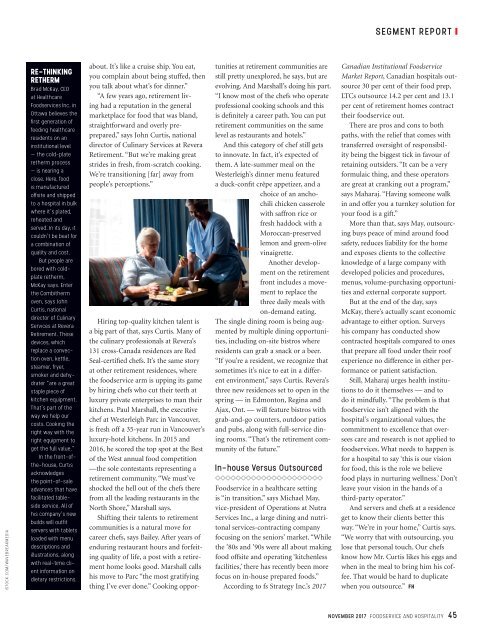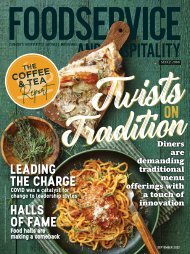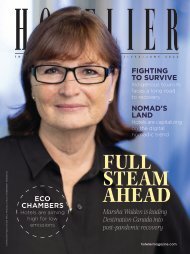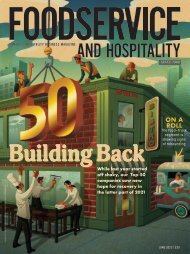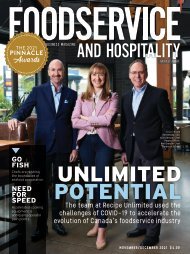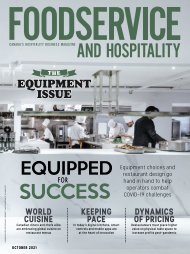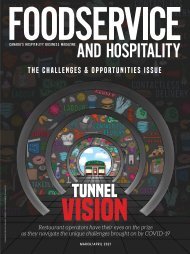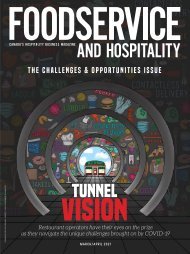FH1117
Create successful ePaper yourself
Turn your PDF publications into a flip-book with our unique Google optimized e-Paper software.
SEGMENT REPORT<br />
iSTOCK.COM/WAVEBREAKMEDIA<br />
RE-THINKING<br />
RETHERM<br />
Brad McKay, CEO<br />
at Healthcare<br />
Foodservices Inc. in<br />
Ottawa believes the<br />
first generation of<br />
feeding healthcare<br />
residents on an<br />
institutional level<br />
— the cold-plate<br />
retherm process<br />
— is nearing a<br />
close. Here, food<br />
is manufactured<br />
offsite and shipped<br />
to a hospital in bulk<br />
where it’s plated,<br />
reheated and<br />
served. In its day, it<br />
couldn’t be beat for<br />
a combination of<br />
quality and cost.<br />
But people are<br />
bored with coldplate<br />
retherm,<br />
McKay says. Enter<br />
the Combitherm<br />
oven, says John<br />
Curtis, national<br />
director of Culinary<br />
Services at Revera<br />
Retirement. These<br />
devices, which<br />
replace a convection<br />
oven, kettle,<br />
steamer, fryer,<br />
smoker and dehydrater<br />
“are a great<br />
staple piece of<br />
kitchen equipment.<br />
That’s part of the<br />
way we help our<br />
costs. Cooking the<br />
right way with the<br />
right equipment to<br />
get the full value.”<br />
In the front-ofthe-house,<br />
Curtis<br />
acknowledges<br />
the point-of-sale<br />
advances that have<br />
facilitated tableside<br />
service. All of<br />
his company’s new<br />
builds will outfit<br />
servers with tablets<br />
loaded with menu<br />
descriptions and<br />
illustrations, along<br />
with real-time client<br />
information on<br />
dietary restrictions.<br />
about. It’s like a cruise ship. You eat,<br />
you complain about being stuffed, then<br />
you talk about what’s for dinner.”<br />
“A few years ago, retirement living<br />
had a reputation in the general<br />
marketplace for food that was bland,<br />
straightforward and overly preprepared,”<br />
says John Curtis, national<br />
director of Culinary Services at Revera<br />
Retirement. “But we’re making great<br />
strides in fresh, from-scratch cooking.<br />
We’re transitioning [far] away from<br />
people’s perceptions.”<br />
Hiring top-quality kitchen talent is<br />
a big part of that, says Curtis. Many of<br />
the culinary professionals at Revera’s<br />
131 cross-Canada residences are Red<br />
Seal-certified chefs. It’s the same story<br />
at other retirement residences, where<br />
the foodservice arm is upping its game<br />
by hiring chefs who cut their teeth at<br />
luxury private enterprises to man their<br />
kitchens. Paul Marshall, the executive<br />
chef at Westerleigh Parc in Vancouver,<br />
is fresh off a 35-year run in Vancouver’s<br />
luxury-hotel kitchens. In 2015 and<br />
2016, he scored the top spot at the Best<br />
of the West annual food competition<br />
—the sole contestants representing a<br />
retirement community. “We must’ve<br />
shocked the hell out of the chefs there<br />
from all the leading restaurants in the<br />
North Shore,” Marshall says.<br />
Shifting their talents to retirement<br />
communities is a natural move for<br />
career chefs, says Bailey. After years of<br />
enduring restaurant hours and forfeiting<br />
quality of life, a post with a retirement<br />
home looks good. Marshall calls<br />
his move to Parc “the most gratifying<br />
thing I’ve ever done.” Cooking opportunities<br />
at retirement communities are<br />
still pretty unexplored, he says, but are<br />
evolving. And Marshall’s doing his part.<br />
“I know most of the chefs who operate<br />
professional cooking schools and this<br />
is definitely a career path. You can put<br />
retirement communities on the same<br />
level as restaurants and hotels.”<br />
And this category of chef still gets<br />
to innovate. In fact, it’s expected of<br />
them. A late-summer meal on the<br />
Westerleigh’s dinner menu featured<br />
a duck-confit crêpe appetizer, and a<br />
choice of an anchochili<br />
chicken casserole<br />
with saffron rice or<br />
fresh haddock with a<br />
Moroccan-preserved<br />
lemon and green-olive<br />
vinaigrette.<br />
Another development<br />
on the retirement<br />
front includes a movement<br />
to replace the<br />
three daily meals with<br />
on-demand eating.<br />
The single dining room is being augmented<br />
by multiple dining opportunities,<br />
including on-site bistros where<br />
residents can grab a snack or a beer.<br />
“If you’re a resident, we recognize that<br />
sometimes it’s nice to eat in a different<br />
environment,” says Curtis. Revera’s<br />
three new residences set to open in the<br />
spring — in Edmonton, Regina and<br />
Ajax, Ont. — will feature bistros with<br />
grab-and-go counters, outdoor patios<br />
and pubs, along with full-service dining<br />
rooms. “That’s the retirement community<br />
of the future.”<br />
In-house Versus Outsourced<br />
Foodservice in a healthcare setting<br />
is “in transition,” says Michael May,<br />
vice-president of Operations at Nutra<br />
Services Inc., a large dining and nutritonal<br />
services-contracting company<br />
focusing on the seniors’ market. “While<br />
the ’80s and ’90s were all about making<br />
food offsite and operating ‘kitchenless<br />
facilities,’ there has recently been more<br />
focus on in-house prepared foods.”<br />
According to fs Strategy Inc.’s 2017<br />
Canadian Institutional Foodservice<br />
Market Report, Canadian hospitals outsource<br />
30 per cent of their food prep,<br />
LTCs outsource 14.2 per cent and 13.1<br />
per cent of retirement homes contract<br />
their foodservice out.<br />
There are pros and cons to both<br />
paths, with the relief that comes with<br />
transferred oversight of responsibility<br />
being the biggest tick in favour of<br />
retaining outsiders. “It can be a very<br />
formulaic thing, and these operators<br />
are great at cranking out a program,”<br />
says Maharaj. “Having someone walk<br />
in and offer you a turnkey solution for<br />
your food is a gift.”<br />
More than that, says May, outsourcing<br />
buys peace of mind around food<br />
safety, reduces liability for the home<br />
and exposes clients to the collective<br />
knowledge of a large company with<br />
developed policies and procedures,<br />
menus, volume-purchasing opportunities<br />
and external corporate support.<br />
But at the end of the day, says<br />
McKay, there’s actually scant economic<br />
advantage to either option. Surveys<br />
his company has conducted show<br />
contracted hospitals compared to ones<br />
that prepare all food under their roof<br />
experience no difference in either performance<br />
or patient satisfaction.<br />
Still, Maharaj urges health institutions<br />
to do it themselves — and to<br />
do it mindfully. “The problem is that<br />
foodservice isn’t aligned with the<br />
hospital’s organizational values, the<br />
commitment to excellence that oversees<br />
care and research is not applied to<br />
foodservices. What needs to happen is<br />
for a hospital to say ‘this is our vision<br />
for food, this is the role we believe<br />
food plays in nurturing wellness.’ Don’t<br />
leave your vision in the hands of a<br />
third-party operator.”<br />
And servers and chefs at a residence<br />
get to know their clients better this<br />
way. “We’re in your home,” Curtis says.<br />
“We worry that with outsourcing, you<br />
lose that personal touch. Our chefs<br />
know how Mr. Curtis likes his eggs and<br />
when in the meal to bring him his coffee.<br />
That would be hard to duplicate<br />
when you outsource.” FH<br />
NOVEMBER 2017 FOODSERVICE AND HOSPITALITY 45


